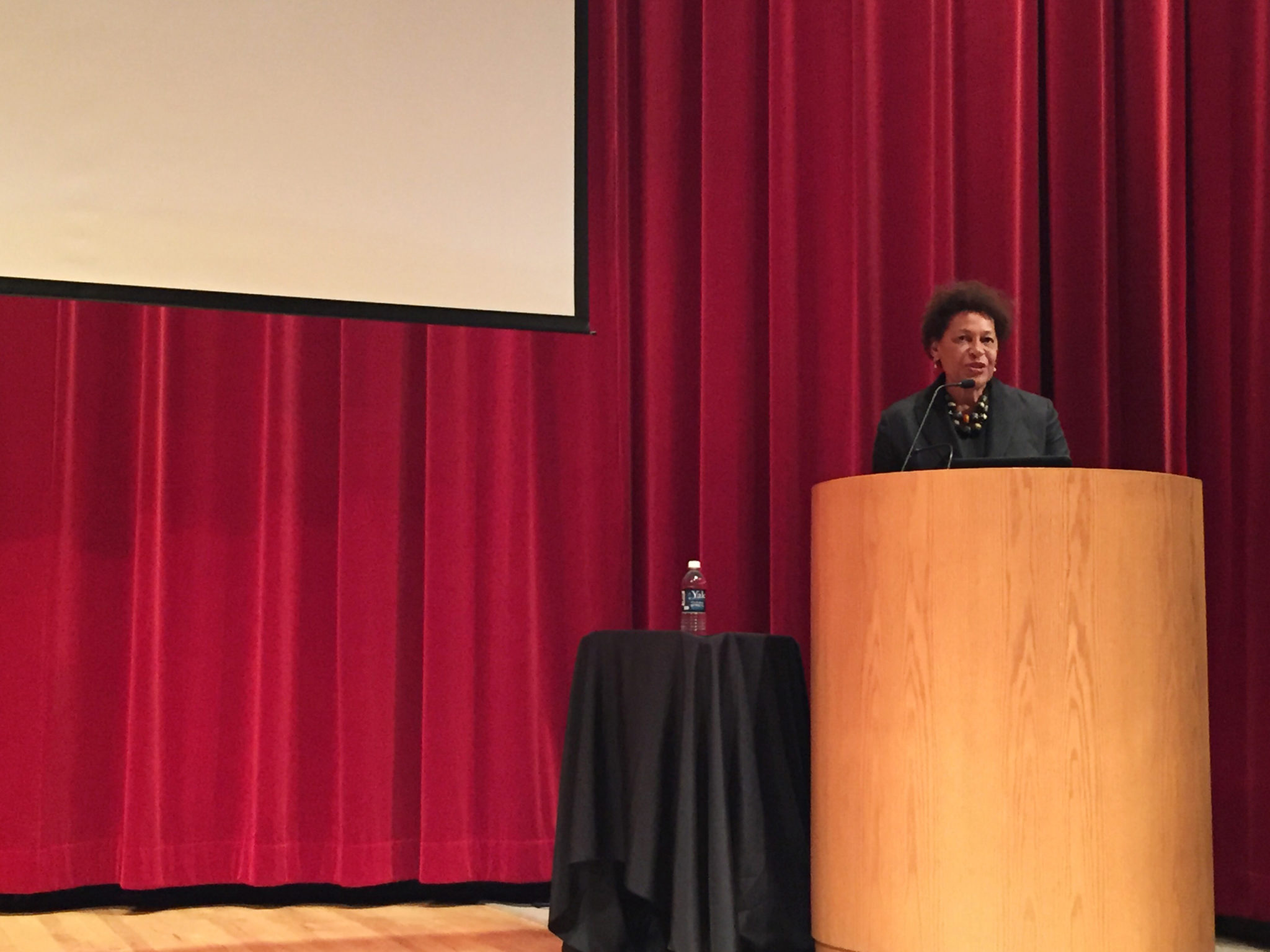
After her acclaimed performance “Grace Notes: Reflections for Now” at the Yale Repertory Theatre in September, multimedia artist Carrie Mae Weems returned to deliver a lecture — “Past Tense” — at the Yale University Art Gallery yesterday evening.
In a lecture that flowed seamlessly through mediums of video, imagery and narration, Weems talked about appropriating other art as a form of progress, her role in convening different artists and the fundamental ideas that inform her large and varied body of work. YUAG Acting Director Pamela Franks described Weems’ work as “topical, urgent and necessary,” while YUAG Associate Curator of Programs Molleen Theodore said that Weems’ work returns to themes of sexism, class and control.
Nearly 400 people attended the event, which included snippets of her various bodies of work such as the “The Museum Series,” the “Kitchen Table Series” and her staged performance at Yale at the beginning of the semester.
“Knowing the precarious and tense political moment we are in, and the climate of the country, there were lots of conversations that needed to happen about Yale’s institutional connection to slavery,” Theodore said. “[‘Grace Notes: Reflections for Now’] seemed like a work that could be a catalyst for conversations that we began last year and are continuing to have now.”
Weems encouraged students not to be afraid of being influenced by other artists, who have historically always referenced one another. She said her work focuses on illuminating humor alongside depictions of tragedy, and such moments of humor were exemplified in her video works and the text components of her pieces.
She also showed the audience “The Museum Series,” flicking through several projected images of herself in a billowing black ensemble, facing away from the camera before the vast facades of the world’s great museums, such as the Louvre in Paris and the National Gallery of Modern Art in Rome. Through these photographs, Weems introduced her fascination with the sexuality of architecture.
“We know there are buildings we can or can’t go in,” she said, relating the idea to the architecture of Yale within the broader city of New Haven. “Architecture either isolates or invites us.”
Weems also spoke about “Grace Notes: Reflections for Now,” her first major foray into performance and theater that was performed in two sold-out shows at the Yale Rep. The multimedia performance in collaboration with artists of several disciplines was inspired by President Barack Obama’s rendition of “Amazing Grace” at the funeral of Rev. Clementa Pinckney, one of nine people killed in the June 2015 South Carolina shootings. Theodore said that she was excited that Yale had the opportunity to enjoy a follow-up lecture.
According to Franks, Weems’ art speaks to a range of disciplines across campus, reflected in the 31 organizations that co-sponsored “Grace Notes: Reflections for Now” in September. Organizations such as the Yale Chaplain’s Office and the Yale University Office of New Haven and State Affairs provided free and subsidized tickets respectively to enable a range of people to experience the performance.
“Her lecture reflected her great versatility,” Theodore said. “She functions so eloquently and powerfully in different modes.”
Franks also said that several Yale professors teach Weems’ art — which Theodore said often interrogates African-American stereotypes — in their classes, particularly African American Studies professor Hazel Carby.
Complementing Weems’ lecture and performance at Yale is an installation at the YUAG, entitled “American History Revisited.” In the exhibition are works from “Slave Coast,” Weems’ photographic series published in 1993 and based on a trip she took to Africa. Theodore said the photographs focus on the legacy and locales of slavery in Africa. Other artists represented in the exhibit include Titus Kaphar ART ’06 and Martin Puryear.
The installation, in the Modern and Contemporary Art permanent galleries on the third floor of the YUAG, was also the location of the YUAG’s “(Inter)sections” programs. Between “Grace Notes: Reflections for Now” and Weems’ lecture yesterday, the YUAG hosted three artists involved in the performances in September in “interdisciplinary dialogue” with students, according to Theodore, where students had the opportunity to interact with each artist through their respective medium. The artists, Carl Hancock Rux, Eisa Davis and Alicia Hall Moran, were hosted in the presence of these historically significant artworks. The installation is on view through Feb. 20, 2017.
“The idea was to bring in interdisciplinary artists in the space of art for conversations that can be had across disciplines,” Theodore said.
Weems’ lecture was part of the Andrew Carnduff Ritchie series, a fund named for a former YUAG director of the same name and jointly held by the YUAG and the Yale Center for British Art.







